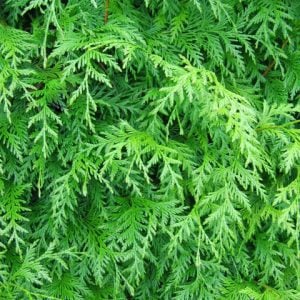Thuja plicata, also known as Western Red Cedar, is a conifer that looks similar to Green Leylandii and grows almost as fast. It has dark, olive-green leaves that can turn bronze in winter. The foliage has a pleasant, fruity fragrance when the leaves are crushed. Thuja plicata can be cut back into old wood and will re-shoot.
Thuja | Western Red Cedar
Thuja plicata
Western Red Cedar, is a conifer that looks similar to Green Leylandii and grows almost as fast. It has dark, olive-green leaves that can turn bronze in winter. The foliage has a pleasant, fruity fragrance when the leaves are crushed. It can be cut back into old wood and will re-shoot.
Read more
Thuja plicata [Western Red Cedar] 110-125cm (3’8″-4’2″)
3’ 8″ – 4’ 2″ Height
110 cm – 125 cm Height

Thuja plicata (Western Red Cedar) 150-175cm
4’ 11″ – 5’ 8″ Height
150 cm – 174 cm Height

Thuja plicata [Western Red Cedar] 180-200cm (5’11”- 6’5″)
5’ 11″ – 6’ 5″ Height
180 cm – 210 cm Height

Thuja plicata [Western Red Cedar] 200-220cm (6’6″- 7’3″)
6’ 6″ – 7’ 3″ Height
200 cm – 220 cm Height

Thuja plicata [Western Red Cedar] 220-240cm (7’3″-7’10”)
7’ 3″ – 7’ 10″ Height
220 cm – 240 cm Height

Thuja plicata (Western Red Cedar) 240-250cm (7’10”-8’2″)
7’ 10″ – 8’ 2″ Height
240 cm – 250 cm Height

Thuja plicata [Western Red Cedar] 300-325cm (9’8″-10’8″)
9’ 8″ – 10’ 8″ Height
300 cm – 325 cm Height
Planting Advice
Thuja | Western Red Cedar

How tall will Thuja plicata grow?
You can keep a Thuja hedge at any height and as narrow as 45cm (18in). It withstands clipping very well. Remember, if you keep a hedge at 2-3m (6-8ft) tall (or lower), it is much easier to trim than if you let it grow taller. If left untrimmed, Western Red Cedar will grow up to 20-35 metres tall (70-120ft) and makes a fabulous specimen tree – but you obviously need a lot of space for this. Specimen trees can be seen in the gardens of many stately homes such as Stourhead and Bicton Park..
How often would I need to trim a Thuja plicata hedge?
Trim your hedge once or twice a year. Late spring/early summer is the best time to trim the hedge. If you think it needs another trim, then trim again in late summer/early autumn but don’t leave it too late before the winter – allow some time for re-growth before the winter cold.

Why plant Thuja plicata (Western Red Cedar)?
- Fast growing
- Evergreen
- Good for screening and all year round privacy
- Acts as a windbreak
- Hardy
- Will re-shoot from old wood
- Scented foliage
- Grows in any soil (apart from water-logged)
- Grows in sunny or shady areas
What type of soil does a Thuja plicata hedge need?
Thuja will grow in any free-draining soil (i.e. any soil that is not water-logged). It will even grow on shallow chalk soils.

How far apart should I plant Thuja plicata?
You should plant between 60 and 100cm (2-3ft) apart. If you want the gaps between the plants to fill in quickly to form a hedge, then plant at 60cm (2ft) apart. If you are happy to wait a bit longer, then plant at 1m (3ft) apart because you will get just as good a hedge, it will just take about a year or so longer for the plants to join together to form a hedge.
Use Our
Hedge Spacing Calculator
Additional Information
Thuja | Western Red Cedar
The many varieties of Thuja plicata
There are a number of different varieties of such as ‘Atrovirens’, ‘Gelderland’, ‘Excelsa’ and ‘Martin’, all of which grow quickly and form a good hedge.
There is also a variegated variety, called Thuja plicata ‘Zebrina’ which is slower growing but still forms a good hedge. Please give us a call if you are interested in this variety.
All varieties of Thuja plicata with green foliage are the best as fast-growing hedging plants along with Thuja occidentalis ‘Brabant’ which grows at a similar rate.
Alternatives to Western Red Cedar
Green Leylandii is similar to Western Red Cedar and grows slightly faster, as a result, it is usually cheaper.
Thuja occidentalis ‘Brabant’ is very similar to Thuja plicata. It has a similar rate of growth and forms a dense evergreen hedge.
Laurel (Prunus laurocerasus) is a quick-growing, evergreen shrub – so if you don’t want a conifer, Laurel is the fastest growing evergreen hedging plant.
Thuja occidentalis ‘Emerald’ is a slower growing conifer that needs very little maintenance. It does not need clipping on the sides as it never grows very wide, however, you can prune the tops once a year to keep the hedge to the height you want.


